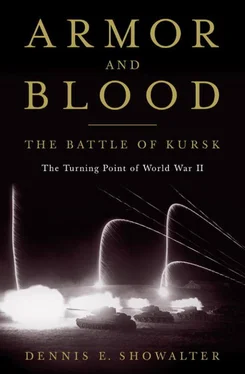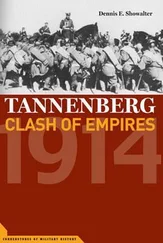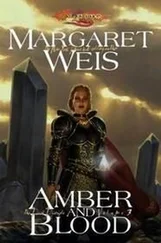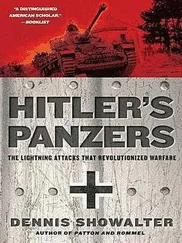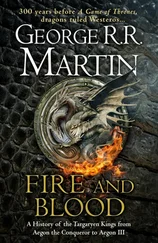The situation could not be changed by an officer corps whose professionalization was consistently retarded not only by the crosscurrents of Communist Party demands, but by a significant sense that a commission was a route of upward mobility in the Soviet order and that in a continuing environment of scarcity, officers deserved special treatment and special privileges. At regimental levels, the officers never set a comprehensive example—never became a bridge between the conscripted lower ranks and the Soviet system. Nor did the noncommissioned officers (NCOs) develop as a facilitating body between men and systems in the Western fashion.
Stalin’s Great Purge of the late 1930s did not spare the Red Army. Recent statistics indicating that less than 10 percent of the officers were actually removed overlook the ripple effects, in particular the diminishing of the mutual rapport and confidence so important for the kind of war that the Germans brought with them and that the Soviets proposed to wage. In response to substandard performances in Poland and Finland, the Red Army restored a spectrum of behaviors and institutions abolished after the Revolution of 1917, designed collectively to introduce more conventional discipline and reestablish the authority of officers and senior NCOs. These changes did not sit well with the “reluctant soldiers” of the rank and file. Nor did they fit well on officers who were themselves profoundly uncertain of their positions.
One result was a significant decline in training standards already mediocre. Western images shaped largely by German myths describe the Russian soldier of World War II as a “natural” fighter, whose instincts and way of life inured him to hardship in ways foreign to “civilized” men. The Red Army was in fact based on a society and a system whose hardness and brutality prefigured and replicated military life. Stalin’s Soviet Union was a society organized for violence, with a steady erosion of distinctions and barriers between military and civilian spheres. If armed struggle never became the end in itself that it was for fascism, Soviet culture was nevertheless comprehensively militarized in preparation for a future revolutionary apocalypse. Soviet political language was structured around military phrasing. Absolute political control and comprehensive iron discipline, often gruesomely enforced, helped bridge the still-inevitable gaps between peace and war. But in the summer of 1941, too many officers and men, active soldiers and recalled reservists, were ignorant of such basics as minor tactics and fire discipline. They would fight—but too often did not know how.
That disconnect was replicated at the levels of doctrine and planning. For the emerging Soviet Union, war was not a contingency but a given. The external class enemy, the capitalist states surrounding the USSR, sought its destruction from their own objective dynamics. Preparing for war, total war, was a pragmatic imperative, implemented in a context that defined war as a science. Marxism-Leninism, the USSR’s legitimating ideology, was a science. The Soviet state and Soviet society were organized on abstract, scientific principles. Studied systematically and properly applied, these principles made it possible to anticipate the consequences of decisions, behaviors—even attitudes. War making too was a science. The application of its objective principles by trained and skilled engineers was the best predictor of victory.
In that matrix, a rising generation of technocrats saw the Soviet Union’s military future in terms of a mass mechanized army. In the mid-1920s, instructors at the Red Army Military Academy described the total destruction of enemy forces by a series of “deep operations”: shock armies for breakthrough, mobile echelons for exploitation and pursuit. Mikhail Tukhachevsky, appointed deputy people’s commissar for military and naval affairs in 1931, was the focal point of a school of thought arguing that mechanization vitalized and extended revolutionary war. A technologized mass army could export communism as well as defend it. “Reluctant soldiers” would be transformed into enthusiasts by experiencing directly what the Soviet Union could do to its enemies. They would become part of a new proletariat, able to make optimum use of the military technologies created under communism.
Stalin internalized and epitomized the conviction that the non-Communist world embodied an irreconcilable hatred for the Soviet system. Even the Great Depression did not change his mind: capitalism in its death throes might be even more willing to undo history by turning its armed forces against the USSR. However intensely managers, soldiers, and officials might dispute specific policies or details of production, the basic assumption of isolation in a mortally hostile world went unchallenged throughout the period. Moderation in defense planning was criminal. Cycles of purge, disruption, and reorganization characterized the defense industry well before they became a general norm in the late 1930s.
The Red Army’s unwavering support for Stalin in the intraparty struggles of the 1920s reflected its appreciation for Stalin’s support of military spending at the expense of balanced budgets and civilian production, to a permanent “half war, half peace” level. “Deep battle” became a comprehensive doctrine that included air-supported, fully mechanized mobile groups taking the fight into the enemy’s rear at a rate of twenty-five or thirty miles a day. By 1938, the Soviet order of battle included four tank corps and a large number of tank brigades. But in November 1939, these formations were disbanded, replaced by motorized divisions and tank brigades designed essentially for close infantry support.
One reason for this measure—the public one—was that the Spanish Civil War had shown the relative vulnerability of tanks, while large armored formations had proved difficult to control both against the Japanese in Mongolia and during the occupation of eastern Poland. Reinforcing operational experience was Stalin’s concern for the armored force as a potential domestic threat. Not only were the top-level advocates of mobile war, men like Tukhachevsky, eliminated—all but one commander at brigade level and 80 percent of the battalion commanders were replaced as well.
The successes of Hitler’s panzers combined with the winding down of the purges to encourage reappraisal. Beginning in 1940, the People’s Commissariat of Defense began authorizing what became a total of twenty-nine mechanized corps, each with two tank divisions and a motorized division: thirty-six thousand men and over a thousand tanks each, plus twenty more brigades of three hundred light T-26 tanks intended for infantry support. The numbers are mind-boggling even by subsequent Soviet reckoning. But low maintenance standards kept field strength down, and the sheer size of the mechanized corps defied all but the best efforts at command and control.
As the Germans drove toward Moscow in 1941, the Red Army began rebuilding virtually from the ground up. Infantry, the rifle divisions, remained the backbone, but their authorized strength was reduced to around eleven thousand and their supporting arms and services were cut to minimums. Even vehicles were reduced by two-thirds, and most of those were horse-drawn. These frugal formations were supplemented by a large number of brigades less than half their size. The new structures reflected not only the heavy losses in men and equipment during Barbarossa, but also the fact that effective command of more complex formations was simply beyond the skill of the colonels and junior generals who took the places of those killed, captured, or replaced.
Higher command structures were correspondingly simplified. Divisions—four or five, sometimes more—were for a time assigned directly to rifle armies, which also controlled most of the service and support elements. During 1942, as supplies of armor and artillery increased, communications improved, and staff work grew more competent, the rifle corps reemerged to enhance flexibility. A rifle army might field three or four of them, each with three or four divisions, sometimes upgraded from the independent brigades, which disappeared in their turn.
Читать дальше
